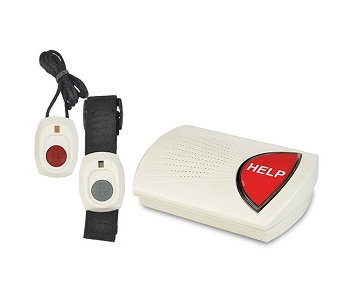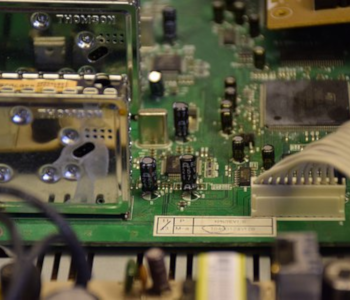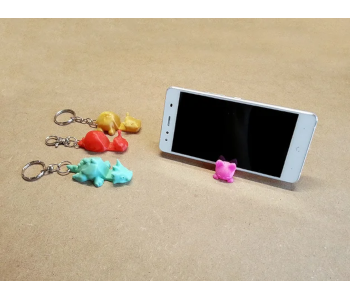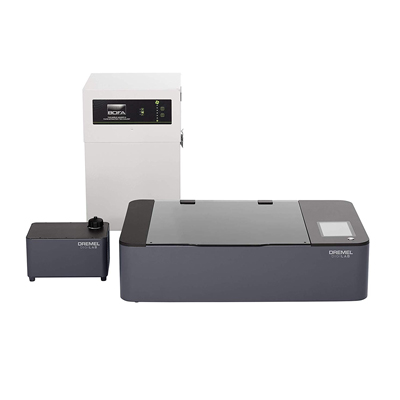Thinking of Starting a Laser Engraving Business? Read This
Modern technology has created a lot of creative and innovative opportunities for new businesses. Helping as well are the evolving consumer trends that put a premium on fast, affordable, and personalized products.
Laser engraving is one of the best examples of how sophisticated technology can be harnessed for use in relatively mundane but profitable applications. Laser technology isn’t exactly new, but it is only in the past years that it has become more accessible both in terms of price and ease of use. How does laser engraving work exactly, and what industries can it serve? What are its advantages over more old-fashioned engraving methods? How much should you expect to spend to start a laser engraving business?
What is laser engraving, and how does it work?
Lasers are some of the most versatile technology ever created. They can produce enough heat to cut through metal or can be delicate enough for medical surgery. They are used for fiber optic communication, media storage and access, 3D scanning, and aerial topographic surveys. In a smaller scale, it is this same versatility that has helped make laser engraving businesses very profitable.
Laser engraving is a process in which a highly focused beam of light, or a laser, is directed to a specific point or along a pattern in a medium. The energy from the laser creates very accurate markings on the medium, the depth and color of which can be controlled by changing the parameters of the laser. The markings made on the medium are a result of the laser vaporizing the material or the material flaking off the surface of the medium.
Industrial and commercial applications of laser engraving
One of the biggest strengths of a laser engraving business is that it can serve a wide range of clients. Whether you’re going for a mom-and-pop scale of business that offers its services to individual customers or a large firm that serves other businesses and manufacturers, having laser engraving technology is sure to bring in the customers. Here are some of the potential clients for your future laser engraving business:
1. Jewelry
![]()
Creating customized jewelry isn’t a new thing. It can even be argued that customizing jewelry gives it that extra boost of flair and appeal. In the old days, customized jewelry was purely handmade. While those methods were certainly impressive, they also took a lot of time.
With laser engraving, customized pieces of jewelry can be created much faster and with better repeatability. There are generally two methods used in laser engraving of jewelry: ablating, which involves vaporizing a thin layer of the surface of the medium, and annealing, which only changes the color of the material without scraping any of it away. In any case, the amount of work that a jewelry artisan can do in several hours using traditional methods can be finished by a laser engraver in a matter of seconds.
Laser engraving has also given jewelry makers more design freedom. Lasers are incredibly accurate and can recreate any digital design. All the latest trends in wedding bands have been made so much easier to execute by laser engraving technology, such as bands with the fingerprints or the handwritten names of the couple. Lasers are so accurate that it’s even possible to engrave “storybook rings” – rings adorned with several lines of text.
2. Automotive parts

Automotive manufacturing is an industry where quality and reliability are extremely important. Each part that goes into an automobile has to pass the strictest quality standards, as the quality is virtually equivalent to the safety of its end users. This means that there needs to be a reliable system of traceability for all of the more than 20,000 parts involved in making a single car. At this scale, the marking method for traceability needs to be completely automated and can work with dynamic data.
This is where laser engraving technology comes in. Aside from being completely automated, laser engraving is precise enough to create marks on the smallest automotive parts, including radiator caps and ignition coils. It can readily mark automobile components based on dynamic data such as barcodes, serial numbers, and even QR codes. Anything safety-related that goes into a car, such as seat belts airbag components, are meticulously marked with traceability codes so that proper accountability can be determined should something go wrong.
Even the interior parts of the car are marked and labeled using laser engraving technology. Those tick marks on the speedometer and the labels on the various buttons on the windshield panel are all likely engraved by lasers. There might even be parts of the car that you wouldn’t think that a car manufacturer would bother marking – such as windshield wipers and side mirrors – are probably still very subtly marked to protect the brand against counterfeits.
What makes laser engraving especially suitable for automobile manufacturing is that it’s incredibly fast. Since it takes less than 5 seconds to engrave detailed designs on small automobile components, laser engraving can be seamlessly integrated into any existing manufacturing process without causing it to slow down.
3. Medical devices and instruments

In 2007, the Food and Drug Administration (FDA) issued a directive requiring all medical devices to bear a unique identifier. Known as Unique Device Identification (UDI), these codes were the foundation for a system of traceability for all medical devices. The objectives of this directive were to improve patient safety, increase device surveillance, and facilitate innovations.
A major requirement of UDI codes is that they should be readable by humans and machines. This meant that the medical industry needed the technology to produce accurate and legible marks on medical devices – a task that proved to be perfect for laser engraving technology.
Laser engraving is incredibly precise, able to create extremely fine details such as the name of the manufacturer, serial numbers, batch numbers, and production dates. Best of all, all these details remain legible even on the smallest items.
The medical applications of laser etching extend to dozens of medical devices – surgery tools, orthopedic implants, sample bottles, and even on those thin plastic cannulas used to deliver IV fluids into patients.
Since marking using laser technology does not use any inks or toxic compounds, it is completely safe for use on items that will go through intimate human contact. Marks used by lasers also have impressive resistance against chemicals and can withstand high-temperature sterilization without degrading.
4. Electronics

We don’t need to discuss how big the electronics industry is. Every day, there are millions of circuit boards, electrical components, semiconductors, and metal and plastic compartments manufactured to serve both the commercial and industrial electronics sector. With more advanced technology comes smaller and smaller electrical components. This unique combination of miniaturized items at a high production volume is the perfect setting for laser engraving technology.
Laser engraving can be used t mark various electrical components with traceability information such as barcodes, UID codes, QR codes, serial numbers, part numbers, and logos. If you have a PCB or any computer chip lying around in your house, go check it out and you’ll probably see a series of codes that the manufacturer has placed. Not only do these codes help brands keep track of their products, but they can also be used to verify warranty claims and to ensure trademark protection.
The assertion that laser engraving is capable of creating highly detailed marks already seems belabored at this point, but it’s one of the characteristics that makes laser technology a seamless fit in the manufacturing of electronic parts. After all, circuit boards and components can be incredibly small. This not only makes them challenging to label but also renders them particularly fragile – which brings us to our next point.
Laser engraving is a non-contact technology. This means that no sharp or hard moving parts need to come into contact with the fragile electronic parts to create the needed marks. In fact, the medium for laser engraving doesn’t even need to be clamped down. This greatly reduces the possibility of electrical components suffering mechanical damage due to the marking process, thereby also reducing the number of rejects.
5. Gift items

Laser engraving doesn’t have to be limited to large-scale manufacturing processes. You can also run a small laser engraving business that caters to small batches of personalized gift items. These items can either be for individual customers, like those who merely want a personalized keychain, mug, or necklace charm.
A far bigger market for custom laser engraved gift items comes from businesses who want to have a selection of promotional items that bear their company name and logo. The most common examples of these are pens, USB sticks, flashlights, lighters, notebooks, and umbrellas. Since laser engraving is remarkably flexible, it can be used across a wide range of items made from different materials and with different geometries.
When it comes to corporate giveaways or personal gifts, the quality of the marked or engraved design is a priority. After all, a low-quality promotional or gift item will reflect poorly on the business or person giving it.
What makes laser engraving attractive for small-scale production is that it’s remarkably easy to learn. Many manufacturers offer turnkey laser engraving equipment that comes with detailed guides and manuals and a very manageable learning curve. The software that comes with a good laser engraving equipment should also be easy to use; think of it like printing a digital design on a piece of paper, except you’ll now be able to print it on virtually anything.
Advantages of laser engraving over traditional methods
1. Accurate
The accuracy of laser engraving is only limited by the size of the narrow beam of laser that hits the medium. In most cases, this beam is extremely small – at the magnitude of 0.001 inch with an error margin of 0.0005 inch both ways. In terms of resolution, this translates to about 500dpi or 600dpi, which is certainly detailed enough for most applications. At this level of accuracy, you can even recreate photorealistic designs on the medium of your choice or fit in several lines of text on the inside surface of a ring. A great benefit of using such an accurate marking method is that text and graphics remain legible, even when they are incredibly small.
2. Fast
In terms of speed, no other marking technology can rival laser engraving. Since it has minimal moving parts and can “burn” through any material almost instantly, it typically takes less than five seconds for a laser engraver to recreate detailed designs. This speed has made it very easy for many manufacturing processes to integrate laser engraving into their current workflow. If you will run a small laser engraving business, this speed will also help you reduce the turnover of your products.
3. Versatile
There are two sides to the versatility of laser engraving: material and geometry. Laser engraving has been used in virtually all the common manufacturing materials. Wood, metal, plastics, textile, paper, concrete – name it, lasers can probably make marks on it. It’s not even necessary to do any tedious and time-consuming tool changes when shifting from one material to the other. The operator only needs to take a few seconds to change the power settings of the laser.
A benefit of laser engraving being a non-contact process is that it doesn’t care what the shape of the object is. Lasers can be used to make marks on flat, curved, or perfectly round surfaces without problems. Does your client want a custom-designed bowling ball? That’s not even a challenge with laser engraving.
4. Permanent
In contrast to other labeling methods, laser engraving uses no ink or other chemical compounds. Instead, the marks are made on the medium itself, either by heating it up to effect a change in color or by vaporizing a very small amount of material. The biggest advantage of such a method is that the marks made by laser engraving are permanent. They don’t fade over time and don’t deteriorate even when subjected to repeated physical or chemical stress. Have you ever had a painted coffee mug fade over time because of constant use? That would not have happened if the design on the coffee mug was laser engraved.
5. Non-contact
Before laser engraving, the most popular way to mark products without using ink was through the dot peen process. In dot peen marking, a carbide or diamond stylus repeatedly strikes the medium to create deep marks on it. These patterns are made using a series of dots, thus the name of the technology.
The problem with dot peen marking is that it wasn’t suitable for fragile items. An item that goes through dot peen marking is subjected to a lot of mechanical stress and repeated impact – factors that are bound to cause some damage to the item at some point.
Laser engraving is particularly suited for creating permanent and legible marks on items that are at high risk of getting damaged. Since hardly any part of the laser engraver ever comes in contact with the medium, there’s also very little risk of secondary damage.
6. Does not rely on scale
The economics of laser engraving is the same whether you’re working on a batch of hundreds of items or just a single piece of jewelry for that special occasion. This makes your business exceptionally flexible in that you can accept that order for a personalized wedding band just as easily as you can accept an order for thousands of printed control boards. Since laser engraving does not need any consumables, you never need to worry about an order being too small for you turn a profit.
7. Easy to learn
The technology of laser engraving has matured to a point where you can now buy a turnkey laser engraver that comes out of the box almost ready to use. These laser engravers come with detailed guides and manuals that will help an operator learn how use it within a few hours. It may even already have pre-sets for different types of materials so that engraving on metal or paper doesn’t have to be a guessing game. In other words, operating a laser engraver isn’t any more difficult than the usual desktop printer in everyone’s homes.
8. Environmentally friendly
Laser engraving has proven to be an appealing technology, especially in today’s market where consumers and manufacturers are on the search for more sustainable and environmentally friendly alternatives to existing techniques. Since laser engraving uses no inks or chemical compounds, you also will no longer need to deal with the disposal of potentially toxic waste materials. The parts of a laser engraving machine go through very little wear and tear, so there’s also very little reason for parts to be replaced over the lifetime of a laser engraver.
Things to consider when buying your first laser engraver

According to current estimates, it’s possible for you to start a laser engraving business with just a little less than $8000. A huge portion of this cost, as expected, will go towards buying your first laser engraver. The right choice of a laser engraver is a critical ingredient to the success of your business, and the following are the technical specs that you should be on the lookout for:
1. Power
There are a lot of affordable and low-power laser engravers in the market, but we highly recommend getting one with a maximum power output of at least 25 watts. This laser should be powerful enough for use with the most common materials, although engraving metals may take longer. If you have the budget, going up to a 50-watt laser is also a good option, but we consider 25 watts as the magic number for novices.
2. Size of the build platform
When it comes to the size of the build platform for your laser engraver, the general rule of thumb is – the bigger, the better. The most common models have platforms with dimensions of either 12” x 16” or 12” x 18”. These should be large enough for most applications and are perfectly acceptable for home-based or storefront businesses. If you can afford it, however, we highly recommend getting an engraver with a build platform that is at least 12” x 24”. This size gives you much more flexibility for working with large engraving stocks and whole material sheets.
3. Quality of service
We cannot stress this enough: the quality of service that the brand of your laser engraver offers can make or break your laser engraving business. This is particularly important while you’re just starting out, as you’re bound to run into technical issues that will fall beyond your troubleshooting capabilities. Buying a cheap laser engraver is absolutely not worth it if it comes with poor technical support and unreliable maintenance service.
Final thoughts
Laser engraving is just another of those new business ideas that leverage greatly on modern technology. The best thing about is that it’s still relatively uncommon, which gives you the opportunity to offer a unique service to wide clientele.
We hope that this guide has helped you make a more informed decision on starting a laser engraving business. Although the capital expense to start a laser engraving business is still high, we believe that the industry has enough potential to take a chance at it. Are you interested in reading more about laser engravers? Let us know in the comment box below!

